UNIT–2
Vector differential calculus
Vector function- A vector function can be defined as below-
If a vector ‘r’ is a function of a scalar variable ‘t’, then-

We define the derivative of a vector function as-

We can denote it as- 
Similarly  is the second order derivative of
is the second order derivative of 
Note-  gives the velocity and
gives the velocity and  gives acceleration.
gives acceleration.
Rules for differentiation-
1. 
2. 
3. 
4. 
5. 
Example-1: A particle moves along the curve  , here ‘t’ is the time. Find its velocity and acceleration at t = 2.
, here ‘t’ is the time. Find its velocity and acceleration at t = 2.
Sol. Here we have-

Then, velocity

Velocity at t = 2,
= 
Acceleration = 
Acceleration at t = 2,

Example-2: If  and
and  then find-
then find-
1. 
2. 
Sol. 1. We know that-




2.



Suppose f(x, y, z) be the scalar function and it is continuously differentiable then the vector-

Is called gradient of f and we can write is as grad f.
So that-

Here  is a vector which has three components
is a vector which has three components 
Properties of gradient-
Property-1: 
Proof:
First we will take left hand side
L.H.S = 
= 
= 
= 
Now taking R.H.S,
R.H.S. = 
= 
= 
Here- L.H.S. = R.H.S.
Hence proved.
Property-2: Gradient of a constant (
Proof:
Suppose 
Then 
We know that the gradient-


= 0
Property-3: Gradient of the sum and difference of two functions-
If f and g are two scalar point functions, then

Proof:
L.H.S 




Hence proved
Property-4: Gradient of the product of two functions
If f and g are two scalar point functions, then

Proof:




So that-

Hence proved.
Property-5: Gradient of the quotient of two functions-
If f and g are two scalar point functions, then-

Proof:
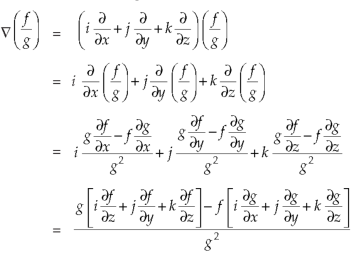
So that-

Example-1: If  , then show that
, then show that
1. 
2. 
Sol.
Suppose  and
and 

Now taking L.H.S,

Which is 
Hence proved.
2. 
So that

Example: If  then find grad f at the point (1,-2,-1).
then find grad f at the point (1,-2,-1).
Sol.



Now grad f at (1 , -2, -1) will be-


Example: If  then prove that grad u , grad v and grad w are coplanar.
then prove that grad u , grad v and grad w are coplanar.
Sol.
Here- 


Now-


Apply 


Which becomes zero.
So that we can say that grad u, grad v and grad w are coplanar vectors.
Directional derivative-
Let ϕ be a scalar point function and let ϕ(P) and ϕ(Q) be the values of ϕ at two neighbouring points P and Q in the field. Then,

 ,
, are the directional derivative of ϕ in the direction of the coordinate axes at P.
are the directional derivative of ϕ in the direction of the coordinate axes at P.
The directional derivative of ϕ in the direction l, m, n=l + m
+ m +
+ 
The directional derivative of ϕ in the direction of  =
= 
Example: Find the directional derivative of 1/r in the direction  where
where 
Sol. Here 
Now,




And 
We know that-

So that-

Now,
Directional derivative = 
Example: Find the directional derivative of

At the points (3, 1, 2) in the direction of the vector  .
.
Sol. Here it is given that-





Now at the point (3, 1, 2)-

Let  be the unit vector in the given direction, then
be the unit vector in the given direction, then
 at (3, 1, 2)
at (3, 1, 2)
Now,


Example: Find the directional derivatives of  at the point P(1, 1, 1) in the direction of the line
at the point P(1, 1, 1) in the direction of the line 
Sol. Here




Direction ratio of the line  are 2, -2, 1
are 2, -2, 1
Now directions cosines of the line are-

Which are 
Directional derivative in the direction of the line-

Divergence (Definition)-
Suppose  is a given continuous differentiable vector function then the divergence of this function can be defined as-
is a given continuous differentiable vector function then the divergence of this function can be defined as-

Curl (Definition)-
Curl of a vector function can be defined as-

Note- Irrotational vector-
If  then the vector is said to be irrotational.
then the vector is said to be irrotational.
Vector identities:
Identity-1: grad uv = u grad v + v grad u
Proof:
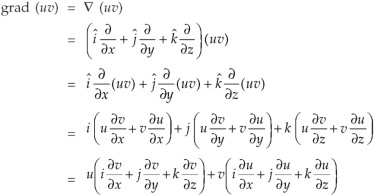
So that
Graduv = u grad v + v grad u
Identity-2: 
Proof:
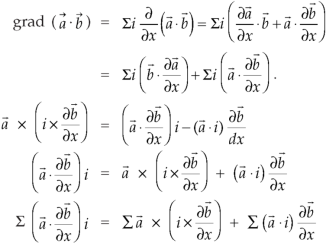

Interchanging  , we get-
, we get-

We get by using above equations-

Identity-3
Proof: 
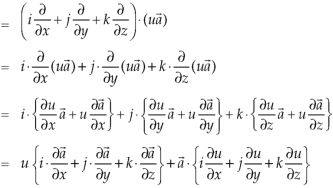
So that-

Identity-4
Proof:
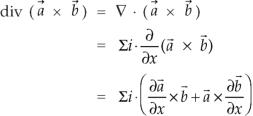


So that,

Identity-5 curl (u
Proof:
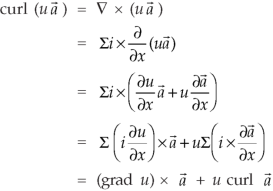
So that
Curl (u
Identity-6: 
Proof:

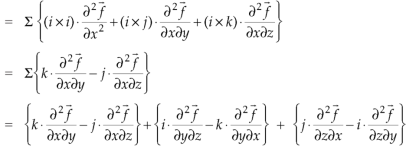
So that-

Identity-7: 
Proof:
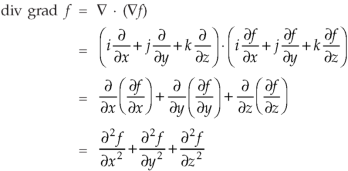
So that-

Example-1: Show that-
1. 
2.
Sol. We know that-




2. We know that-




 = 0
= 0
Example-2: If  then find the divergence and curl of
then find the divergence and curl of  .
.
Sol. we know that-


Now-


Example-3: Prove that 
Note- here  is a constant vector and
is a constant vector and 
Sol. Here  and
and 
So that

Now-
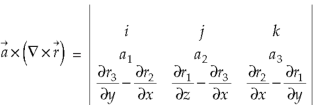


So that-

Example-4: Find the curl of F(x,y,z) = 3 i+2zj-xk
i+2zj-xk
Ans.
Curl F = 
=
=  i -
i - 
= (0-2)i-(-1-0)j+(0-0)k
= -2i+j
Example-5: What is the curl of the vector field F= ( x +y +z ,x-y-z, )?
)?
Solution:
Curl F = 
= 
=
= (2y+1)i-(2x-1)j+(1-1)k
= (2y+1)i+(1-2x)j+0k
= (2y+1, 1-2x,0)
Example-6: Find the curl of F = ( )i +4zj +
)i +4zj +
Solution:
Curl F=
= 

=(0-4)i-(2x-0)j+(0+1)k
=(-4)i – (2x)j+1k
=(-4,-2x,1)
Solenoidal field-
Ansolenoidal field F is characterised by the following conditions-
1. 
2. Flux  along every closed surface is zero.
along every closed surface is zero.
3. 
Note- In an solenoidal field for which , the vector F can always be expressed as the curl of a vector function V.
, the vector F can always be expressed as the curl of a vector function V.
So that-

Irrotational field-
An irrotatonal field F is characterised by the following conditions-
1. 
2. Circulation along every closed surface is zero.
along every closed surface is zero.
3. 
Note- In an irrotational field for which , the vector F can always be expressed as the gradient of a scalar function
, the vector F can always be expressed as the gradient of a scalar function  provided the domain is simply connected.
provided the domain is simply connected.
So that-

Here the scalar function is called the potential.
Example-1: Prove that the vector field  is irrotational and find its scalar potential.
is irrotational and find its scalar potential.
Sol. As we know that if  then field is irrotational.
then field is irrotational.
So that-

So that the field is irrotational and the vector F can be expressed as the gradient of a scalar potential,
That means-

Now-
 ………………… (1)
………………… (1)
 ……………………. (2)
……………………. (2)
Integrating (1) with respect to x, keep ‘y’ as constant-
We get-
 …………….. (3)
…………….. (3)
Integrating (1) with respect to y, keep ‘x’ as constant-
We get-
 …………….. (4)
…………….. (4)
Equating (3) and (4)-

 and
and
So that-

Example-2:Prove that the vector field  is solenoidal and irrotational.
is solenoidal and irrotational.
Sol. We know that if  then the vector field will be solenoidal.
then the vector field will be solenoidal.
So that-

= 
So that the vector field is solenoidal.
Now for irrotational field we need prove- 
So that-



Thus, the vector field F is irrotational.
Example-3:Show that the vector field  is irrotational and find the scalar potential function.
is irrotational and find the scalar potential function.
Sol. Now for irrotational field we need prove- 
So that-

So that the vector field is irrotational.
Now in order to find the scalar potential function-



